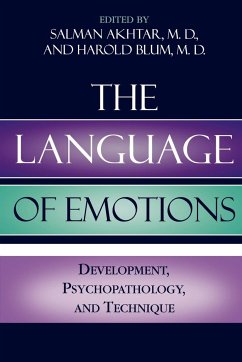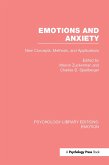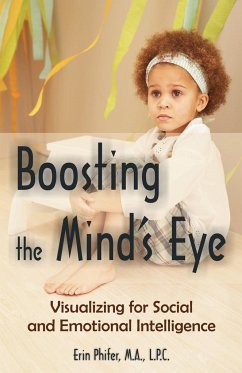The Language of Emotions
Developmental, Psychopathology, and Technique
Herausgeber: Akhtar, Salman; Blum, Harold P.
The Language of Emotions
Developmental, Psychopathology, and Technique
Herausgeber: Akhtar, Salman; Blum, Harold P.
- Broschiertes Buch
- Merkliste
- Auf die Merkliste
- Bewerten Bewerten
- Teilen
- Produkt teilen
- Produkterinnerung
- Produkterinnerung
This book is about affect-its origins, development and uses-and how it is viewed in a clinical setting. The authors track and further develop the recent major changes in the understanding of affect. From its roots in childhood development to its cross-cultural aspects, affect remains clinically relevant in issues such as aggression and forgiveness.
Andere Kunden interessierten sich auch für
![Anger Goes Up, Fear Goes Down- Emotions and the Hidden Link Anger Goes Up, Fear Goes Down- Emotions and the Hidden Link]() Cairo P. RochaAnger Goes Up, Fear Goes Down- Emotions and the Hidden Link13,99 €
Cairo P. RochaAnger Goes Up, Fear Goes Down- Emotions and the Hidden Link13,99 €![The Culture of Shame The Culture of Shame]() Andrew P. MorrisonThe Culture of Shame61,99 €
Andrew P. MorrisonThe Culture of Shame61,99 €![The V-Spot The V-Spot]() Joan LachkarThe V-Spot128,99 €
Joan LachkarThe V-Spot128,99 €![ABC's of Emotions ABC's of Emotions]() Howard V. OtterholtABC's of Emotions14,99 €
Howard V. OtterholtABC's of Emotions14,99 €![Emotions and Anxiety Emotions and Anxiety]() Emotions and Anxiety212,99 €
Emotions and Anxiety212,99 €![Keeping Emotions In Check Keeping Emotions In Check]() Kimberly HarrisKeeping Emotions In Check15,99 €
Kimberly HarrisKeeping Emotions In Check15,99 €![Boosting the Mind's Eye Boosting the Mind's Eye]() Erin PhiferBoosting the Mind's Eye37,99 €
Erin PhiferBoosting the Mind's Eye37,99 €-
-
-
This book is about affect-its origins, development and uses-and how it is viewed in a clinical setting. The authors track and further develop the recent major changes in the understanding of affect. From its roots in childhood development to its cross-cultural aspects, affect remains clinically relevant in issues such as aggression and forgiveness.
Hinweis: Dieser Artikel kann nur an eine deutsche Lieferadresse ausgeliefert werden.
Hinweis: Dieser Artikel kann nur an eine deutsche Lieferadresse ausgeliefert werden.
Produktdetails
- Produktdetails
- Verlag: Jason Aronson, Inc.
- Seitenzahl: 200
- Erscheinungstermin: 4. Januar 2005
- Englisch
- Abmessung: 229mm x 152mm x 11mm
- Gewicht: 298g
- ISBN-13: 9780765703286
- ISBN-10: 0765703289
- Artikelnr.: 21646944
- Herstellerkennzeichnung
- Libri GmbH
- Europaallee 1
- 36244 Bad Hersfeld
- gpsr@libri.de
- Verlag: Jason Aronson, Inc.
- Seitenzahl: 200
- Erscheinungstermin: 4. Januar 2005
- Englisch
- Abmessung: 229mm x 152mm x 11mm
- Gewicht: 298g
- ISBN-13: 9780765703286
- ISBN-10: 0765703289
- Artikelnr.: 21646944
- Herstellerkennzeichnung
- Libri GmbH
- Europaallee 1
- 36244 Bad Hersfeld
- gpsr@libri.de
Salman Akhtar, M.D., is professor of psychiatry at Jefferson Medical College, lecturer on psychiatry at Harvard Medical School, and training and supervising analyst at the Psychoanalytic Center of Philadelphia. He is author of Broken Structures (1992),Quest for Answers (1995),Inner Torment (1999) andImmigration and Identity (1999). His more than 175 scientific publications also include eighteen edited or co-edited books. Dr. Akhtar is the recipient of the Journal of the American Psychoanalytic Association's Award (1995), the Margaret Mahler Literature Prize (1996), ASPP's Sigmund Freud Award (2000), and the Edith Sabshin Award of the American Psychoanalytic Association (2000). He has also published five volumes of poetry. Harold P. Blum, M.D., is clinical professor of psychiatry and supervising and training analyst at the Psychoanalytic Institute of the New York University Medical Center. He is also the Executive Director of the Sigmund Freud Archives and has been the editor of the Journal of the American Psychoanalytic Association. Dr. Blum is the author of more than 115 psychoanalytic papers and several books. He is the recipient of numerous awards including the inaugural Sigourney Awards, Mahler Literature Prize, Heinz Hartman Award, and Sandor Lorand Prize. He has delivered the prestigious Sigmund Freud, Anna Freud, Heinz Hartman, and A.A. Brill Lectures and has given two plenary addresses to the American Psychoanalytic Association.
Chapter 1 Language of Affect Chapter 2 Affects in Development and Clinical
Work-Discussion of Blum's Chapter "Language of Affect" Chapter 3
Cross-Cultural Varieties in Experiencing Affect Chapter 4 Joint Looking,
Shared Experiencing, and Verbalizing Affects in the United States and
Japan-Discussion of Kitayama's Chapter "Cross-Cultural Varieties in
Experiencing Affect" Chapter 5 Separation-Individuation, Object Constancy,
and Affect Regulation Chapter 6 The Internal Monster: An Aspect of Hostile
Self and Object Constancy-Discussion of Tyson's Chapter
"Separation-Individuation, Object Constancy, and Affect Regulation" Chapter
7 Forgiveness: Origins, Development, Psychopathology, and Technical
Relevance Chapter 8 Acceptance, Mourning, and the Metabolism of
Aggression-Two Discussions of Akhtar's Chapter "Forgiveness" Chapter 9
Observations and Representations of the Earliest Relationship: A View from
Separation-Individuation and Attachment Chapter 10 The Intergenerational
Legacy-Discussion of Bergman and Fahey's Chapter "Observations and
Representations of the Earliest Relationship" Chapter 11 Language and
Affect-A Concluding Overview
Work-Discussion of Blum's Chapter "Language of Affect" Chapter 3
Cross-Cultural Varieties in Experiencing Affect Chapter 4 Joint Looking,
Shared Experiencing, and Verbalizing Affects in the United States and
Japan-Discussion of Kitayama's Chapter "Cross-Cultural Varieties in
Experiencing Affect" Chapter 5 Separation-Individuation, Object Constancy,
and Affect Regulation Chapter 6 The Internal Monster: An Aspect of Hostile
Self and Object Constancy-Discussion of Tyson's Chapter
"Separation-Individuation, Object Constancy, and Affect Regulation" Chapter
7 Forgiveness: Origins, Development, Psychopathology, and Technical
Relevance Chapter 8 Acceptance, Mourning, and the Metabolism of
Aggression-Two Discussions of Akhtar's Chapter "Forgiveness" Chapter 9
Observations and Representations of the Earliest Relationship: A View from
Separation-Individuation and Attachment Chapter 10 The Intergenerational
Legacy-Discussion of Bergman and Fahey's Chapter "Observations and
Representations of the Earliest Relationship" Chapter 11 Language and
Affect-A Concluding Overview
Chapter 1 Language of Affect Chapter 2 Affects in Development and Clinical
Work-Discussion of Blum's Chapter "Language of Affect" Chapter 3
Cross-Cultural Varieties in Experiencing Affect Chapter 4 Joint Looking,
Shared Experiencing, and Verbalizing Affects in the United States and
Japan-Discussion of Kitayama's Chapter "Cross-Cultural Varieties in
Experiencing Affect" Chapter 5 Separation-Individuation, Object Constancy,
and Affect Regulation Chapter 6 The Internal Monster: An Aspect of Hostile
Self and Object Constancy-Discussion of Tyson's Chapter
"Separation-Individuation, Object Constancy, and Affect Regulation" Chapter
7 Forgiveness: Origins, Development, Psychopathology, and Technical
Relevance Chapter 8 Acceptance, Mourning, and the Metabolism of
Aggression-Two Discussions of Akhtar's Chapter "Forgiveness" Chapter 9
Observations and Representations of the Earliest Relationship: A View from
Separation-Individuation and Attachment Chapter 10 The Intergenerational
Legacy-Discussion of Bergman and Fahey's Chapter "Observations and
Representations of the Earliest Relationship" Chapter 11 Language and
Affect-A Concluding Overview
Work-Discussion of Blum's Chapter "Language of Affect" Chapter 3
Cross-Cultural Varieties in Experiencing Affect Chapter 4 Joint Looking,
Shared Experiencing, and Verbalizing Affects in the United States and
Japan-Discussion of Kitayama's Chapter "Cross-Cultural Varieties in
Experiencing Affect" Chapter 5 Separation-Individuation, Object Constancy,
and Affect Regulation Chapter 6 The Internal Monster: An Aspect of Hostile
Self and Object Constancy-Discussion of Tyson's Chapter
"Separation-Individuation, Object Constancy, and Affect Regulation" Chapter
7 Forgiveness: Origins, Development, Psychopathology, and Technical
Relevance Chapter 8 Acceptance, Mourning, and the Metabolism of
Aggression-Two Discussions of Akhtar's Chapter "Forgiveness" Chapter 9
Observations and Representations of the Earliest Relationship: A View from
Separation-Individuation and Attachment Chapter 10 The Intergenerational
Legacy-Discussion of Bergman and Fahey's Chapter "Observations and
Representations of the Earliest Relationship" Chapter 11 Language and
Affect-A Concluding Overview








